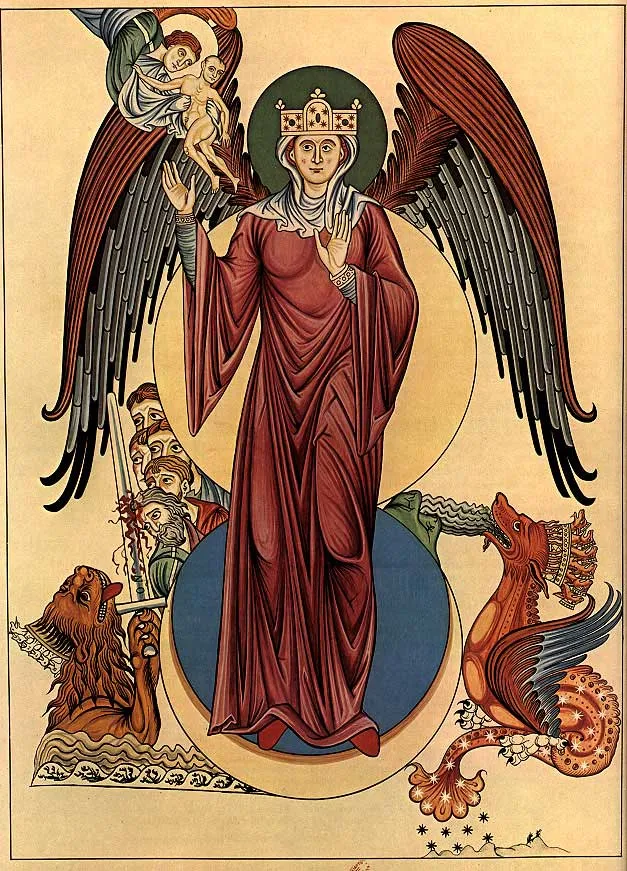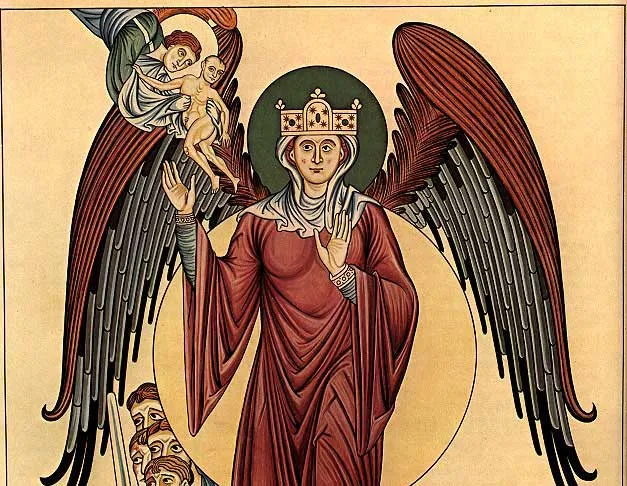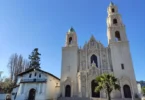
Introduction
The Woman of the Apocalypse (or woman clothed with the sun, Greek: γυνὴ περιβεβλημένη τὸν ἥλιον, romanized: gynē peribeblēmenē ton hēlion; Mulier amicta sole) is a figure described in Chapter 12 of the Book of Revelation (written c. AD 95).
Woman of the Apocalypse – The woman gives birth to a male child who is threatened by a dragon, identified as the Devil and Satan, who intends to devour the child as soon as he is born. When the child is taken to heaven, the woman flees on eagle’s wings into the wilderness at “palace prepared” for 1,260 days. This leads to a “War in Heaven” in which the angels cast out the dragon. The dragon attacks the woman, but the woman escapes on her wings for “a time, times and a time and a half” i.e. 1,260 days (the duration of each of three periods).
Woman of the Apocalypse – The dragon then attacks her again with a flood of water from his mouth, which is subsequently swallowed by earth. Frustrated, the dragon initiates war on “the remnant of her seed”, identified as the righteous followers of Christ. The Woman of the Apocalypse is widely identified as the Virgin Mary. This interpretation is held by some commentators of the ancient Church as well as in the medieval and modern Catholic Church. This view does not negate the alternative interpretation of the Woman representing the Church, as in Catholic teaching, Mary is both the Mother of God and the Mother of the Church.
Some Catholic commentaries, such as Thomas Haydock’s Catholic Bible Commentary (1859), allow for the interpretation of the woman as either the Church or Mary. The commentary of the New American Bible (the official Catholic Bible for America) states that “The woman adorned with the sun, the moon, and the stars (images taken from Genesis 37:9–10) symbolizes God’s people in the Old and the New Testament. The Israel of old gave birth to the Messiah (Rev 12:5) and then became the new Israel, the church, which suffers persecution by the dragon (Rev. 12:6, 13–17); cf. Is. 50:1; 66:7; Jer. 50:12.”
In Protestant churches, including Reformed Churches and the Evangelical Movement, the Woman of the Apocalypse tends to be seen as the Church or Israel.
History of Woman of the Apocalypse
Ancient witnesses to the Marian interpretation include St. Epiphanius, Tychonius (who heavily influenced St. Augustine), the unknown author of the History of Joseph the Carpenter, Quodvultdeus (a disciple of St. Augustine), Cassiodorus (Complexiones in Apocalypsi, written c. 570 AD), and the Greek Fathers Andreas of Caesarea (late 6th c. / early 7th c.) and Oikoumenios (6th c.).
In modern times, the Marian interpretation has been affirmed by Pope Pius X, Pope Pius XII, Pope Paul VI, and Pope John Paul II.
Theological Interpretation
House altar with the Virgin of Quito (18th century) by Bernardo de Legarda. Wood, polychromy. Ethnological Museum of Berlin.
Woman of the Apocalypse – Woman clothed with the Sun as an altar painting in a catholic church (Hungary, Szeged city, Votive Church)
The woman’s “male child” is a reference to Jesus (Revelation 12:5), since he is destined to “rule all nations with a rod of iron” (Revelation 12:5). The dragon trying to devour the woman’s child at the moment of his birth (Revelation 12:4) is a reference to Herod the Great’s attempt to kill the infant Jesus (Matthew 2:16). Through his death and resurrection and Ascension, Jesus “was snatched up to God and to his throne” (Revelation 12:5).
In the interpretation of Pius X (1904), the birth is not that of Jesus but “surely ours,” (i.e. the Church Militant) “we who, being yet detained in exile, are still to be brought forth to the perfect love of God and eternal happiness”. Pius XII (1950) makes explicit the reference to the Assumption of Mary. And John Paul II (1987) to the Protoevangelium interpretation of Genesis 3:15, and by extension the symbolic identification of the Woman with both Mary and Eve.
For an assessment of the logical and theological reasons for identifying the Woman of Revelation 12 with Mary Mother of God, see Brunero Gherardini [it], Raised to Heaven because Co-Redemptrix on Earth. Thoughts on the Foundation of the Catholic Dogma (2012) and D’Argon J-L, “The Apocalypse” in The Jerome Biblical Commentary (1968).
Alternatively, extreme pain in childbirth is seen as a result of the fall by many and the woman has extreme pain in child birth which may cause some tension with a sinless Mary interpretation of the text is an issue to consider. Dr. Mark Miravalle teacher of General Mariology in Mary’s Virginity During the Birth of Jesus: The Catholic Church’s Perennial Tradition.
Also alternatively, some would make the woman Israel and/or the church since in one dream of Joseph’s in Genesis of his father and mother being the sun and moon and his brothers in Gen 37:9.
Veneration
Both Marian veneration and the interpretation of the Woman of the Apocalypse are recorded since at least the 4th century, but the specific veneration of Mary in this form becomes tangible only in the medieval period. Iconographically, Marian figures associated with the Revelation narrative are recognizable by the astronomical attributes, specifically her standing on a crescent moon, and the crown of twelve stars (while the description “clothed with the sun” is sometimes rendered by rays emanating from her figure).
Association of Mary with a single star is recorded from the early medieval period, in the hymn Ave Maris Stella.
Many depictions of Mary from the Gothic period (14th to 16th century) show her standing on a crescent moon inspired by the association of Mary with the woman of the Apocalypse. The motif became so popular in 15th-century Germany that pre-existing Madonna figures were refitted with a crescent (e.g. Madonna of Bad Doberan, c. 1300, refitted in the 15th century). The Virgin of Guadalupe was depicted as the Madonna of the Apocalypse since at least the 16th century.
The Madonna of the Apocalypse became associated with Our Lady of the Rosary, the “crown of twelve stars” being identified with a “rosary of twelve privileges” of Mary. The Virgin of the Rosary is frequently shown with the crown or halo of twelve stars (but not the crescent moon) in modern depictions (since the 19th century). A notable example is the Virgin of the Rosary of Pompei.
An anecdote (first published in the 1980s) connects the design of the Flag of Europe (1955) to this aspect of Marian iconography.
Interpretation as the Church
One early witness to the interpretation of the woman as the church is Hippolytus of Rome who states said interpretation in On Christ and Antichrist.
Commentators who adhere to Protestant theology in their eschatology sometimes identify the woman as the Church, and the man-child she gives birth to are the saints. According to this interpretation, Revelation 12:17 describes the remnant of the seed of the woman as those who keep the commandments of God, and have the testimony of Jesus Christ. The offspring of the Woman, the Woman’s seed, then refers to the saints. The man child “who shall rule the nations with a rod of iron” is a symbol of the faithful members of the Church.
Woman of the Apocalypse – In Revelation 2:18–29, the Church in Thyatira is promised that the faithful shall rule the nations with a rod of iron. In Revelation 19:15 the same thing is stated of Jesus. In Galatians 4:26, Paul the Apostle refers to the “New Jerusalem” as “our mother”, and in Revelation 21:2 and Ephesians 5:21–32 the New Jerusalem and the Church is portrayed as the Bride of Christ.
The Seventh-day Adventist Church identifies itself as the end-time “remnant church” described in Revelation 12:17.
The Catholic Church recognizes the “woman” as part of the polyvalent symbolism that is found in the book in four referents: Israel, the Church, Eve, and Mary.
The Church of Jesus Christ of Latter-day Saints also interprets the woman to be the Church, and the man-child to be the political kingdom that will grow out of the Church prior to or during the Second Coming of Christ; this interpretation arises from Joseph Smith’s translation of the twelfth chapter of Revelation. Some in the church interpret the woman to be a symbol of the earth. Baptisms of fire and water being poured upon the earth and the sun clothing the earth daily are just a couple examples.
The Nation of Israel
A statue of Our Lady of Victory (1654), shown with crescent moon and solar rays, portal of Schlägl monastery church.
A statue of Mary in Strasbourg Cathedral (1859) with a crown of twelve stars.
Dispensational Premillennialists, and Amillennialists who believe in multiple valid interpretations will often identify the woman as the nation of Israel. There are several reasons given to support this interpretation. Woman of the Apocalypse – The woman is said to be clothed with the sun, the moon under her feet, and twelve stars. These symbols are drawn from Genesis 37:9–11, in which Joseph has a dream of the sun and moon symbolizing his father and mother, and stars representing his eleven brothers, which bow down to him. The Old Testament’s prophets referred to Israel as a “woman” (Isaiah 54:5–6; Jeremiah 4:31; Micah 4:9–10).
The woman flees into the wilderness where she is nourished for 1260 days, the equivalent of three and a half years or forty-two months (cf. Rev. 12:6). According to this interpretation, these terms are used prophetically in Scripture either for the first half or the last half of the “Seventieth Week of Daniel,” in Daniel 9:24–27, a prophecy specifically addressed to Daniel and his people, Israel (Dan. 9:24).
In the latter part of the seventieth week, a remnant of Israel will flee into the wilderness to escape the persecution of Antichrist, who is called “the son of destruction,” “the lawless one,” and “whose coming is in accord with the activity of Satan” (2 Thess. 2:1–12; cf. Rev. 12:4,9). Jesus, in the Olivet discourse, warned the people of this time which would occur just prior to His return to set up His earthly, Millennial kingdom (Matt. 24:15–22). Further, the archangel Michael is called the guardian over the sons of Israel in Dan. 12:1. And he will arise at that time of national Israel’s tribulation (Dan. 12:1; cf. Rev. 12:7).
Amillennialist belief can also interpret this passage as the nation of Israel, however this belief as expressed by amillennialists refers, not to the modern Israel, but to the Ancient religious state of Israel (Judea) as it existed in the time of Christ. The Child is Christ, born into the then existing state of Israel, and of Israel’s lineage. The remnant or sons of Israel is, in this understanding, the followers of Christ, the followers of the true religion of Israel as it exists after the coming of the messiah.
The “Seventieth Week of Daniel,” and prophecy of the Olivet discourse, in this belief, are ascribed as concerning the first coming of Christ, the destruction of Jerusalem in 70 AD (during which enforced emperor worship occurred in the temple of Jerusalem, which was later almost totally destroyed, and many Jews were made slaves in distant lands resulting presumably in their remaining families not knowing what happened to them or where they were), and the establishment of Christ’s Church, as it currently exists, both on earth and in heaven.
Lutheran scholar Craig Koester, for example, says, “The woman encompasses the story of Israel, from whom the Messiah was born, as well as the story of the church, which was persecuted after Jesus’ death and resurrection… John’s visionary account of the threat against the woman and the woman’s preservation uses imagery that encompasses many moments in the story of God’s people. This allows the story to apply to people in many times and places.”
Revelation 12
Woman of the Apocalypse – Revelation 12 provides an overview of three major players in the world today and their impact on end-time events. Whom do the woman, Child and dragon represent.
The book of Revelation is a vision from Jesus Christ, given to Him by God the Father, which reveals what is going to happen before His return to establish the Kingdom of God on earth. This fascinating book is also called the Apocalypse, from the Greek word that means revelation. This prophetic book is primarily written in a chronological style with occasional breaks for overviews of specific subjects.
Revelation 12 is one of these overviews, providing a history stretching from the time before humans existed until the time just before Christ’s return as King of Kings and Lord of Lords.
Revelation 12 begins with the statement: “Now a great sign appeared in heaven” (verse 1). The word “sign” comes from the Greek word semeion, meaning “a sign, mark, token … an unusual occurrence, transcending the common course of nature” (Thayer’s Greek Definitions). The first great sign is a vision of a woman who gave birth to a child (verse 1).
Then in verse 3 we read, “And another sign [semeion] appeared in heaven.” We thus understand that these three symbols—a woman, a child and a dragon—represent things beyond the ordinary events of nature. As we are going to see, these three figures symbolize three major spiritual forces that have been at work for several thousand years.
Who is the woman in Revelation 12?
The woman of the Apocalypse — described as being “clothed with the sun, with the moon under her feet, and on her head a garland of twelve stars” (verse 1)—represents Old Testament Israel. In the Old Testament, God referred to His people as a woman whom He had dressed in honor and splendor (Ezekiel 16). The garland with 12 stars may be symbolic of the 12 tribes of Israel (Genesis 37:9-10).
Throughout Revelation 12 we note that the “woman” is repeatedly protected by God (verses 6, 14-16), especially as the time approaches for the “kingdom of our God” to be established on earth (verse 10).
In the New Testament, God’s Church is symbolized as a woman; and its members are likened to virgins (Matthew 25:1-13; Revelation 14:4; Revelation 19:7). The New Testament Church is called “the Israel of God” (Galatians 6:16) and likened to “Jerusalem above,” which is called “the mother of us all” (Galatians 4:26, also see Hebrews 12:22-23). Members of the Church are described as “a chosen generation, a royal priesthood, a holy nation, His [God’s] own special people” (1 Peter 2:9).
When Christ returns to earth, He is going to marry the Church, which is called “His wife” in Revelation 19:7. Read more about Jesus Christ and the Church in our article “Marriage Supper of the Lamb.” Based on these passages, it is clear that the woman in Revelation 12 represents God’s people.
Incidentally, it is also interesting to note that the imagery of a dishonorable woman—one called “the great harlot”—is used in Revelation 17:1 to depict a false church that deceives many. Read more about this in our article “Mystery, Babylon the Great.”
Who is the Child in Revelation 12?
Woman of the Apocalypse – The woman (God’s chosen nation of Israel) is described as giving birth to a “male Child who was to rule all nations with a rod of iron” (Revelation 12:5). Indeed, Jesus Christ was born into this nation. The verse continues, “And her Child was caught up to God and His throne.” The language here makes it clear that Jesus is the “Child” in Revelation 12.
Jesus is the One who is prophesied to “strike the nations. And He Himself will rule them with a rod of iron” (Revelation 19:15). He is also the One who, after His resurrection, was taken up in a cloud to heaven (Acts 1:9-11).
Who is the Dragon?
The third symbol of Revelation 12—“a great, fiery red dragon” (verse 3)—is described as having drawn “a third of the stars of heaven” and standing “before the woman who was ready to give birth, to devour her Child as soon as it was born” (verse 4). A few verses later, this dragon is clearly identified as Satan: “So the great dragon was cast out, that serpent of old, called the Devil and Satan, who deceives the whole world” (verse 9).
As for the dragon drawing “a third of the stars of heaven,” this reference apparently represents Satan leading a third of the angels in a rebellion against God. Other passages show stars represent angels (Revelation 1:20).
The Bible also explains that Satan had been involved in a rebellion against God in which he attempted to exalt his “throne above the stars of God” and “be like the Most High” (Isaiah 14:13-14). Satan then began his work as “that serpent of old [the one who tempted Eve in the Garden of Eden], called the Devil and Satan, who deceives the whole world” (Revelation 12:9, emphasis added throughout). For a more extensive explanation of Satan’s rebellion, see “God vs. Satan.”
If God has “ministers of righteousness,” Satan also has his servants—physical ministers (themselves deceived and helping deceive others) and spirit beings who pass themselves off as righteous but incite human beings to sin (2 Corinthians 11:15; Ephesians 6:12). Jude further describes the fallen angels or demons as “angels who did not keep their proper domain” and who are now “reserved in everlasting chains under darkness for the judgment of the great day” (Jude 1:6).
Woman of the Apocalypse – Revelation 12:3-17 is a concise history of Satan’s efforts to thwart God’s plan to bring many humans to glory as part of His eternal family. Satan’s actions included convincing a third of the angels to follow him in his attempt to make himself like God, attempting to have Christ killed as a child (Matthew 2:13-18), working to deceive the entire world and persecuting God’s people. Let’s now consider in greater detail Satan’s attempts to derail God’s plan.
The Dragon vs. The Child
In Revelation 12:4 we read that “the dragon stood before the woman who was ready to give birth, to devour her Child as soon as it was born.” This appears to be a historical reference to King Herod’s effort to destroy Jesus as a young child by ordering the deaths of all male children from two years old and under who lived in and around Bethlehem (Matthew 2:13-18). But an angel had warned Joseph to flee to Egypt with his wife and Jesus to keep the Child from being destroyed (verse 13).
The Believer’s Bible Commentary notes this about Revelation 12:4-5: “The dragon is ready to devour the Child as soon as He is born—fulfilled in the attempt of Herod the Great, vassal of Rome, to destroy the newborn King of the Jews. The male Child is clearly Jesus, destined to rule all the nations with a rod of iron.”
Even though Satan’s attempt to destroy Jesus when He was a child failed, the devil did not give up. Prior to the beginning of Jesus’ ministry, “Jesus was led up by the Spirit into the wilderness to be tempted by the devil” (Matthew 4:1). During this temptation, Satan tried to get Jesus to violate God’s law and worship him instead of God. The devil offered Jesus “all the kingdoms of the world and their glory” (verse 8) if Jesus would worship him. But Jesus did not do so.
When Jesus’ ministry was fulfilled and it was time for Him to give His life as payment for humanity’s sins, Satan was there once again. On this occasion, Satan was the one who “put it into the heart of Judas Iscariot, Simon’s son, to betray Him” (John 13:2). Although Satan was clearly involved in the crucifixion of Jesus, this was actually part of God’s plan for the redemption of mankind.
As Genesis 3:15 had predicted, there would be ongoing “enmity” between the serpent (Satan) and the woman (God’s people) and the “Seed” (Jesus) who would come from the woman. Furthermore, this passage indicated that Satan would have limited success in being able to “bruise” Christ’s heel by influencing the man who would betray Jesus and that Jesus would “bruise” Satan’s head by resisting his temptations and qualifying to replace him as the ruler of this world.
So why did Satan expend so much effort in his attempts to destroy Jesus? Because if there had not been a perfect Savior to pay the penalty for humanity’s sins, God’s plan would have been thwarted. Without a Savior, humans could not be forgiven of their sins nor could they live forever in God’s eternal family.
The Dragon vs. God’s People
In addition to his efforts to destroy Jesus, Satan has a long history of persecuting God’s people, especially members of God’s Church, represented by the woman in the latter portions of Revelation 12. Although there was fierce persecution from the earliest days of the New Testament Church, God allowed the woman to flee “into the wilderness, where she has a place prepared by God, that they should feed her there one thousand two hundred and sixty days” (verse 6).
This verse indicates that the true Church was protected by God for 1,260 years (see Numbers 14:34 and Ezekiel 4:6, showing that a day can represent a year). During this time—which may have continued through the Middle Ages—the Church was protected from its enemies, including the Roman Empire and false Christianity.
The next two verses then explain that “war broke out in heaven” between Satan and his angels and Michael and his angels. As a result of this war, John, in vision, saw that a place for Satan and his angels was not “found for them in heaven any longer” and they were “cast to the earth” (Revelation 12:7-9). This battle is different from Satan’s original rebellion, which is described in verse 4 and which occurred long before the birth of Christ.
The setting for this battle, described in verses 7-9, and its significance is then announced by a loud voice in heaven (verses 10-12). This battle is an indicator that “the kingdom of our God, and the power of His Christ have [or will soon] come” (verse 10). Prior to this event, Satan has had access to God’s presence to accuse His people (Job 1:6-7; Job 2:1-2). Now he and his angels no longer have this access and are cast down to the earth.
Realizing the significance of this event, Satan the dragon now has “great wrath, because he knows that he has a short time” (Revelation 12:12) before Christ returns to establish the Kingdom of God on earth. He then directs his rage toward God’s people, the ones who are the continuation of the woman of the Apocalypse who gave birth to the male Child (verse 13).
God, however, will not allow Satan to destroy His people. Jesus had promised that the “gates of Hades [the grave]” would not prevail against it (Matthew 16:18). To protect His people, the woman is “given two wings of a great eagle,” meaning she is safely taken into “her place,” where she will be protected for “a time, and times and half a time [apparently 3½ years], from the presence of the serpent” (Revelation 12:14).
Even though Satan will spew “water out of his mouth like a flood,” to try to get at the woman, he will not be successful (verses 15-16). In this passage, the concept of a “flood” likely represents armies (see Isaiah 59:19; Jeremiah 46:7-8).
Satan then goes to “make war with the rest of her [the woman’s] offspring, who keep the commandments of God and have the testimony of Jesus Christ” (Revelation 12:17). From this passage we note that while some members of God’s true Church will be protected from Satan’s wrath during these end times prior to Christ’s return, others will not. Those not in the place of protection will need to prove their allegiance to God the Father and Christ in the face of Satan’s intense persecution.
The Dragon vs. You
Whether you realize it or not, Satan also hates you and will do everything possible to keep you from loving and obeying your Creator. His anger is not just against Jesus and the Church. Why is he angry at you? Apparently, because he realizes that humans were created by God with the potential to be higher than he was (Hebrews 2:6-8).
Because of his sick, twisted and unsound thinking, Satan has taken on the role of being an adversary against those seeking to love and obey their Father in heaven. Writing to the people of God, Peter cautioned, “Be sober, be vigilant; because your adversary the devil walks about like a roaring lion, seeking whom he may devour” (1 Peter 5:8).
In communicating with the brethren in Corinth, Paul described the true gospel as being “veiled” or hidden because of Satan, “the god of this age,” who had blinded the minds of unbelievers (2 Corinthians 4:3-4). The good news is that this “veil is taken away in Christ” (2 Corinthians 3:14).
To learn more about your Savior and His expectations of you, we highly recommend the free booklet Change Your Life! To learn more about the prophecies of Revelation, see the other articles in this section on “Understanding the Mysterious Book of Revelation.”
Feast Day – 15th August
The Church’s liturgical year celebrates on August 15th the Woman of the Apocalypse, “a woman clothed with the sun, with the moon under her feet, and on her head a crown of twelve stars.” The feast is better known in Catholic talk as the Assumption, and the first liturgical reading in the celebration of the Mass contains the above-quoted description of the Woman of the Apocalypse.
The feast of the Assumption is hardly the only feast in the panoply of Marian celebrations on the Church’s liturgical calendar. It is rarely, however, associated with the optional Marian memorial celebrated December 12th, Our Lady of Guadalupe, though it should be, because both feasts are emblematic of the same thing: apocalypse.








